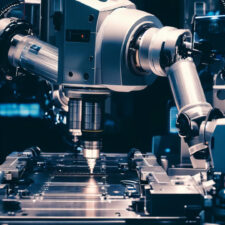Robotic machining machines are becoming increasingly popular in the manufacturing industry. These machines are a type of computer-controlled system used for precision machining. They consist of a robotic arm, end-effector, and tooling, which work together to perform various machining tasks such as cutting, drilling, and milling.
Benefits of Robotic Machining Machines
Robotic machining machines offer several benefits over traditional machining methods. Here are some of the advantages of using robotic machining machines.
Precision
One of the primary benefits of robotic machining machines is their ability to perform high-precision machining tasks. These machines are capable of producing complex parts with tight tolerances, which can be difficult to achieve with traditional machining methods.
Efficiency
Robotic machining machines can work 24/7 without needing breaks, which makes them more efficient than human workers. They can also perform repetitive tasks with high accuracy, which reduces the risk of errors and improves productivity.
Flexibility
Robotic machining machines can be programmed to perform a wide range of machining tasks, making them highly flexible. They can also be reprogrammed quickly to adapt to changes in production requirements.
Safety
Using robotic machining machines can improve safety in the workplace. These machines can perform dangerous and hazardous tasks, such as working with sharp tools or in high-temperature environments, without putting human workers at risk.
Applications of Robotic Machining Machines
Robotic machining machines are used in various industries, including aerospace, automotive, and medical. Here are some of the applications of these machines.
Aerospace
Robotic machining machines are used in the aerospace industry to manufacture components such as engine blades, brackets, and fittings. These machines can produce high-precision parts with complex geometries, which are required for aerospace applications.
Automotive
Robotic machining machines are used in the automotive industry to manufacture parts such as engine blocks, transmission components, and suspension components. These machines can produce large volumes of parts with high accuracy and consistency.
Medical
Robotic machining machines are used in the medical industry to manufacture components such as implants, prosthetics, and surgical instruments. These machines can produce parts with high precision and accuracy, which is essential for medical applications.
Choosing the Right Robotic Machining Machine
Choosing the right robotic machining machine depends on several factors, such as the type of material being machined, the required precision, and the production volume. Here are some of the factors to consider when choosing a robotic machining machine.
Payload Capacity
The payload capacity of a robotic machining machine is the maximum weight it can carry. It is essential to choose a machine with a payload capacity that can handle the weight of the parts being machined.
Reach
The reach of a robotic machining machine is the maximum distance it can reach. It is essential to choose a machine with a reach that can cover the entire workspace.
Accuracy
The accuracy of a robotic machining machine is the degree to which it can repeat a task. It is essential to choose a machine with high accuracy to ensure the quality of the parts being produced.
Programming
The programming of a robotic machining machine determines its capabilities. It is essential to choose a machine with programming capabilities that match the production requirements.
Conclusion
Robotic machining machines offer several benefits over traditional machining methods. They are highly efficient, flexible, and precise, and can improve safety in the workplace. These machines are used in various industries, including aerospace, automotive, and medical, and can produce high-quality parts with complex geometries. When choosing a robotic machining machine, it is essential to consider factors such as payload capacity, reach, accuracy, and programming capabilities.


